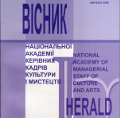ОБРАЗ ОРФЕЯ В МИСТЕЦТВІ ЯК МОДЕЛЬ, ЩО ПОРОДЖУЄ ДІЙСНІСТЬ
Eternal Image of Orpheus in Art as a Model that Creates Reality
Author(s): Valentyn ShtyrbulSubject(s): Visual Arts, Aesthetics, Theory of Literature, Sociology of Art, History of Art, Sociology of Literature
Published by: Національна академія керівних кадрів культури і мистецтв
Keywords: myth about Orpheus; eternal image; adaptation; transformation; symbol of art; alter-ego; turn; the gaze of Orpheus;
Summary/Abstract: The purpose of the study is to analyse the modern embodiment of the eternal image of Orpheus created on the basis of an artistic revaluation of an ancient myth, which over a significant period of its existence has changed its role from the model of archaic society to inclusion in the great cultural context of the art of today. The methodological base of the study consists of a number of methods. Analytical method is used to penetrate the essence of the Orpheus as an artist, which allows us to learn about the motives of his actions. The comparative method is applied to compare and contrast the primary mythological image with its transformed variants. The use of the historical method is necessary in order to trace the development of the eternal image in art in different historical periods. The study of such a well-known image is impossible without the use of a descriptive method since its origins are in mythological sources. The scientific novelty of the study is to consider the eternal image of Orpheus, which exists in art as a generating model of reality. The proof of this thesis is based on the analysis of the examples of modern revaluated embodiment of the mythological plot by giving it the meaning that is relevant to the present socio-cultural meaning. Demonstration of such plot and motive transformations not only eliminates the distance between history and modernity, but also gives rise to a “new” myth that plays the role of a model of new reality. Conclusions. Some well-known plots, being repeatedly told and retold, inevitably undergo changes, significantly moving away from their primary source. The story of Orpheus, reflected in the works of art of different genres, functions as a kind of evolutionary power within the constantly expanding culture. An ancient legend of the Thracian Singer is a constant motif of new creations that not only contradict the cultural and historical development of humankind, but also contribute to it protecting the artistic heritage of the past from cultural oblivion by creating a transformed model of image that is actively involved in the creation of new reality.
Journal: Вісник Національної академії керівних кадрів культури і мистецтв
- Issue Year: 2023
- Issue No: 1
- Page Range: 337-342
- Page Count: 6
- Language: Ukrainian

